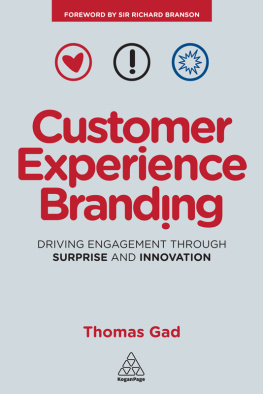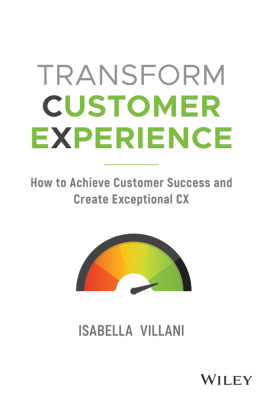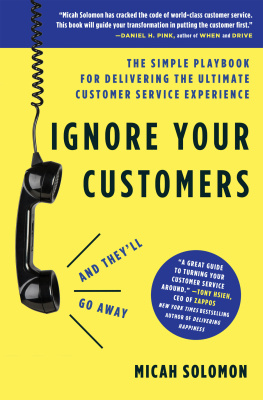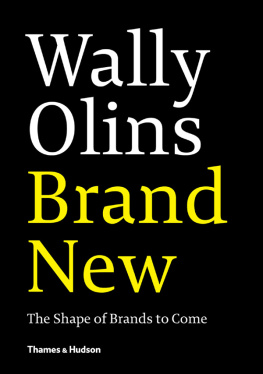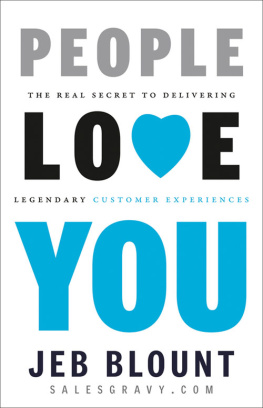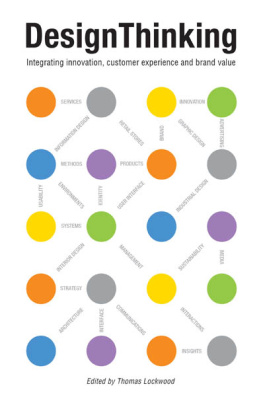About the author
Thomas Gad is an inspirational and experienced international branding authority, with more than 30 years of experience and connections with many famous brands (including Nokia, BMW, Virgin, SAS, Deutsche Bank, Spotify and more).
His acclaimed book 4D Branding , with a foreword by Richard Branson, was published in January 2001 by Financial Times/Prentice Hall.
Thomas Gad also co-wrote a number of books, including Managing Brand Me with Annette Rosencreutz (2002) about personal branding, and he contributed to Beyond Branding (2003) and Brands With A Conscience (2016), both edited by Nicholas Ind.
He is based in Stockholm, Hamburg and Palo Alto, California, and has his own international consultancy business with practices in Scandinavia, Germany, USA, Russia and the UK.
01
Managing perceptions in peoples minds
The word branding no longer properly describes what practitioners of branding mean today. Nor does it describe what they want the word to stand for.
Its the etymology of the word branding that gives the wrong impression. It comes from the language of my ancestors, the Vikings in Sweden, Norway, Denmark and Island. The Old Norse word brandr (meaning to burn) referred to the practice of using a hot iron rod to impress the owners markings or symbols (brands) on cattle, slaves, timber, crockery and more. This practice goes back as far as at least ancient Egypt.
What started as symbol of cattle ownership, warning potential thieves to keep their hands off, evolved over time into a sign of social, political and commercial inclusion. It became a marker of relationships, not just with the owner or producers, but also between people. Depending on context, brands can indicate practices, status, reputation and experiences. They can show relationships between producers, customers, consumers and opinion makers. They can describe quality, availability, price and service, as well as policies, personas, values, beliefs and the general allure of any political, social, commercial or cultural enterprise.
In addition, branding can be activated by a mix of production, service management, media choice, content creation, public relations, logistics and information technology, including social media.
In 2000 I founded the Medinge Group, a think-tank, with some of the worlds leading new thinkers in branding. One of the first things we did was challenge the word branding, only to conclude, a few sessions later, that we could not actually find a better word to describe what branding stands for in our modern minds, despite all the wrong connotations. The good thing is that our brains recognize the word branding through pattern recognition (see ). The history of a word is less important than what you make it into. In this sense, its just the same as any brand that gets its value from what you make of it.
In this chapter Id like to bring your attention to some aspects of branding that you may not have considered, which will help you manage your business.
During all the years of my practice, by far the best definition of branding I have used is managing perceptions in peoples minds . It tells us where the effect of branding takes place in peoples minds and it tells us what that effect is managing perceptions.
A good way to understand what branding does is to consider the opposite: what happens if you do not use branding at all? The amazing thing is that branding takes place anyway. But instead of the brand owner or manager intentionally guiding people, people use their imagination to fill the empty space, this vacuum of information, with their own ideas and fantasies.
This is always the case in situations when there is no available information; the empty space is filled with speculations, and the ideas based on them. People start to speculate, and share their speculations with others. Sometimes, outside commentators try to help by producing statements and comments, still without access to precise facts or real insight into the thinking of the decision makers.
I have never met, or heard of, any brand builders who found the right branding by launching their products with no planned branding effort. I have met their opposites, though, who complain that their brand is not perceived the way it should be, or that their brand is not in the forefront of peoples minds as it is supposed to be. This is often the case with initially cocky brand owners who turn down offers of help with their branding strategy on the grounds that it would be a waste of time and money.
Managing is a key word in explaining what branding is all about. In most companies, there are many different management processes: human resources management, finance management, production management, procurement management, etc. Since branding is one of the most important processes in creating value, both in terms of equity and of the businesss result (profit), it should definitely be considered an important core management process. Unfortunately, in most companies, it is not.
Sometimes this is the result of a traditional point of view. Branding is considered part of the marketing process, and yes, of course, it is an essential part of marketing. But there is much more to branding than just marketing; it is traditionally the basis of the company culture. Branding is usually where the companys vision, mission and values are stated. It is, simply, a sub-set of management strategy in any kind of enterprise, not just commercial. A favourite alternative phrase for branding is company DNA or even company soul.
Example: pirate branding how to manage perception of fear in peoples minds
The marauding pirates of the Caribbean in the iconic pirate era of the 1650s to the 1720s are a very illustrative and dramatic example of effectively managing perception in peoples minds. It begins with the logo of the pirates: the classic flag most commonly attributed to Henry Avery, one of the most infamous pirate captains. The white skull in profile, wearing a kerchief, on a red or black background and with the crossed bones below very clearly depicts the fate of the crews who refused to surrender to the pirates.
An important part of managing the perception of a brand is being clear about what drives the brand owners the why or the purpose and mission of the brand. A widespread myth states that the pirates were only interested in loot, and not in killing. This is why many ships full of merchandise, including gold and other valuables, surrendered relatively easily, with very little fighting. The sailors forced to fight by their ambitious navy officers knew very well that the pirates were outlaws with very little to lose, and that they were therefore extremely dangerous and brutal fighters. Many crews surrendered to pirates only to be recruited into pirate ranks, which not only kept them alive, but also offered monetary rewards. A pirate received one to two shares of the loot (Konstam, 2007) instead of the 19 to 24 shillings a month for a sailor offered by, for instance, the merchant navy (Hill and Ranft, 2002).
Until a few years ago, my answer to the common question on how business strategy and branding strategy are related was that the business strategy comes first, because that is a long term plan of action designed to achieve a particular goal or set of goals or objectives (Glykas, 2012). Making money is usually the main such goal. A business strategy is the managements game plan for strengthening the performance of the enterprise, including creating the business model and identifying the main customer target audience. Being only a brand advisor, I simply wanted to show a lot of respect for the other parts of the business.
Over the past few years, I have changed my mind about what comes first. I now promote the idea that the brand strategy comes first, and the business strategy or plan, including goals of performance and the business model, comes second. The reason for this change is that, in my practice and experience, I have seen too many businesses fail. Not because they havent been able to come up with a very good business model and strategy for making money, but because they havent been attentive enough to customer needs and customer perception.

